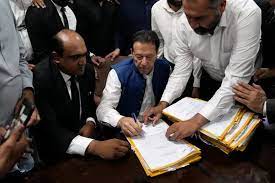By Tirthankar Mitra
Ministry formation is on the rocks in Pakistan after the February 8 elections produced a fractured mandate. Major political parties went scurrying to cobble together a majority coalition even though Imran Khan’s PTI despite winning biggest share of seats and emerging as the largest party in the National Assembly was not accepted as the winner by PML-N and PPP, the two other major political parties.
A confusing picture emerged after PTI pressed its claim and named Omar Ayub as the prime ministerial candidate but found itself without sufficient allies. Instead PML-N headed by Shehbaz Sharif joined hands with PPP attaining the magic figure of 134 NA seats to stake the formation of a coalition government.
But the PPP will not be joining the coalition government and giving PML-N outside support. Reading between the lines, it is learnt that the PPP leadership seeks to maintain its distance from a government which would have little option but to take tough and politically unpopular decisions despite its inner weakness.
It makes the new coalition bid led by PML-N a weak one. It can be toppled any time by PPP. In terms of real politic, the PML-N government will need to keep its prop PPP in good humour. Their differences are so well known. They are uniting to keep out Imran Khan from power.
Presidential post for Asif Zardari is among the fishes and loaves of office which the PPP seeks. A share in the Punjab government and some constitutional posts are also in the PPP’s list in exchange of its support, a reason why several PML-N leaders wanted to concentrate on Punjab instead of going for governance at the Centre.
These issues are in the cards as government formation process is yet to begin formally. Reserve seats are yet to be allocated in keeping with the seats won by the parties when the National Assembly meets.
A marriage of convenience is likely to be worked out as intense bargaining is on among the coalition partners over getting top posts. It has resulted in a big question mark coming up on the stability of the government once it is formed by PML-N. sans any latches and lapses.
A bed of thorns awaits the coalition government as a standby arrangement with IMF ends in April. Given the country’s heavy debt service obligations with IMF, a new and larger programme has to be negotiated.
It will add to the cost of living crisis. Whether the new prime minister will need the support of the allies on this issue remains in doubt. The choice of the finance minister will be critical. For on it hinges the task of building credibility with multilateral financial institutions and of course the IMF.
The new government will have to withstand “backseat driving” as Nawaz Sharif will be calling the shots and Shehbaz Sharif doing his brother’s bidding. Nawaz has agreed to stay away from the government but not from governance giving Shehbaz “borrowed authority’.
The present government will not be a replay of the previous PDM arrangement as PTI had walked out of NA while PPP was part of the government. There was no Opposition then but the PML-N will face a different Opposition with PTI in it. The governance in the provinces will be a daunting task too. Different political parties will run the four provinces following regionalised political outcome.
Imran Khan choosing Al Amin Gandapur, a known hawk as chief minister of Khyber Paktunkhwa is a pointer to a combative approach. Economic difficulties and scarce resources will make it no easy task for Shehbaz Sharif to cope with PPP-run Sindh and Baluchistan.
Pakistan has emerged with the possibility of a tenuous coalition government. More turmoil can worsen the economy adding to the country’s woes. The economically ravaged nation is far away from destination of political stability. (IPA)


